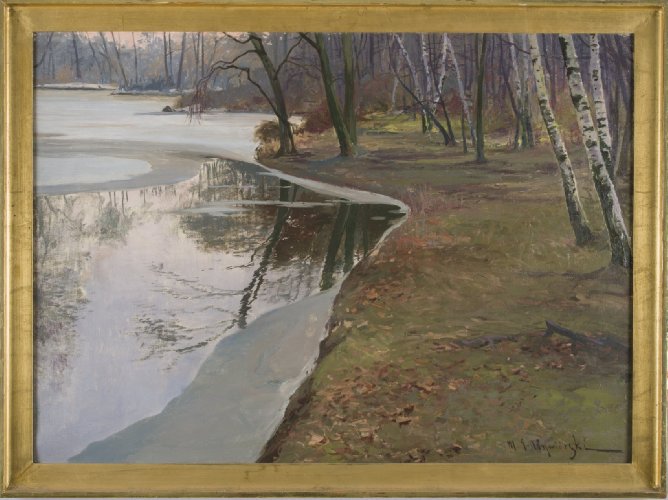Description:
Michał Gorstkin–Wywiórski (1861–1926), after interrupting his studies in chemistry at the Polytechnic Institute of Riga, studied painting at the Munich Academy under Karl Raupp and Nicolaos Gysis, as well as in the private studios of Józef Brandt and Alfred Wierusz–Kowalski between 1883 and 1887. From 1884 onwards he presented his works at numerous exhibitions in Poland and abroad. He lived in Berlin and from around 1904 in Poznań, where he co–founded the Association of Artists and the Society of Friends of Fine Arts, both established in 1909.
At that time, Wywiórski was a frequent guest of the Raczyńskis in Rogalin, where his numerous works inspired by the local landscape were created. Among the most famous are the views of the famous Rogalin oaks from 1907, which can be seen in the Rogalin Gallery.
Wywiórski was primarily a landscape painter, often depicting scenes of hunting, but also the fruits of his travels, numerous maritime and Tatra views. His ability to observe nature and to translate it into a painterly language determined his invitations to participate in fashionable panoramas at the turn of the century. Among them, it is worth mentioning “Berezyna“ from 1895 (painted with Julian Fałat, Wojciech Kossak, Antoni Piotrowski and Jan Stanisławski), or “Napoleon Under the Pyramids“ from 1901 (created with Wojciech Kossak, Józef Ryszkiewicz and Zygmunt Rozwadowski). The completion of the latter and the preparation for the unfinished “Samosierra“ was preceded by a joint trip of the artist with Wojciech Kossak to Egypt and Spain. The visit to these countries probably prompted Wywiórski to use a unique color palette in “Edge of the Pond“, painted after his return.
Description of the painting:
According to the historical titles, this evocative landscape depicts an early-spring view of the shore of a park pond. In the captured fragment, the artist was enchanted by the rhythmically undulating shoreline, which divides the composition into two opposing zones, forming a whole with a great decorative value. The warm tones of the shore, with the awakening green of the grass from under the dried leaves and the brown thickets in the distance, stand out clearly from the cold shades of the thawing pond surface. The delicate, almost muslin fabric of the freed water, reflecting the sky and the riverside vegetation, is the counterweight to the fleshy matter of the earth. It is this, and especially the few leafless trees, that connect the three elements compositionally. This gives a sense of the harmonious fullness of nature, but also of the aesthetic pleasure derived from the play of lines and colors. The white birches and snow on the ice, as well as the pink glow of the sky, find their continuation in the reflections in the water and in the pink-violet shadow of the riverside trees closing the composition, accompany the opposing colors of earth and water.


